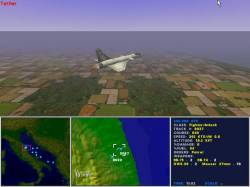
Page 4
Graphics
GameplayThe graphics for the new units are of a uniformly high standard, easily on a par with the originals. It is clear that the WDP 3D designer has spent a huge amount of time on these. As far as I can tell the new ships and aircraft appear to be accurately modelled and all are pleasing and believable to watch in action.
Perhaps the biggest change in gameplay is the way in which the offensive and defensive aspects of anti-ship missiles are treated. Radars do not detect incoming missiles until much later (especially sea-skimming missiles), and enemy units are more likely to fire large salvoes of missiles. Combined with the generally more aggressive behaviour of computer controlled adversaries, a full scale attack on your fleet with missiles is an edge of the seat experience. This is precisely the type of situation that the thoughtfully designed scenarios often lead to, which produces considerably more excitement than I remember from the original game.
Fig. 6. A Swedish JAS-39A heads out over the AdriaticSummaryIt is interesting to play scenarios in the original, and then to play modified versions of the same scenarios after installing the WDP files. In some cases the difference is marked. Enemies are much more difficult to destroy, attacks are much more difficult to survive, and generally it is necessary to play cautiously, probing the enemy defences from a distance before committing to an attack. I enjoyed this much more than the wade-in-and-blast-'em approach that seemed to suffice in many parts of the original game. One of my favourite scenarios in the original was Liberating Liberia, but the revised WDP version is better in almost every respect, with new units, more aggressive behaviour by the rebels and more detailed tasking.
There is no doubt that the WDP files produce more accurate behaviour from the units, sensors and weapons in Fleet Command. There is also no doubt that the team behind WDP is passionate, committed , knowledgeable and willing to respond to ideas and requests from users. However, does all the tweaking of database and doctrine files actually improve the playability of the game? I think that the answer depends on how you felt about the original Fleet Command. If like me you left the original game with a nagging feeling of disappointment that it tended rather too much towards the sim-lite end of the spectrum, then this may be just what you are looking for. The ships, aircraft, weapons and sensors are subject to more realistic limitations, behave in a way that seems more in keeping with known naval doctrine and are considerably more difficult to destroy. Combine this with a plethora of new units, improved graphics and some excellent and thoughtfully designed scenarios and I believe that WDP makes a worthy addition to a good game. It isn't perfect; notably the lack of a campaign is a disappointment and the slowdown on large scenarios could be a problem, but it does genuinely change, improve and extend the original. And its free - now that can't be bad, can it?
Test System:
- Compaq Presario 7477
- AMD-K6-2 533MHz processor
- 64 MB RAM
- Orchid Righteous 3dfx card
For further information on the WDP, you can email Warship or visit the Warship Database Project website.


